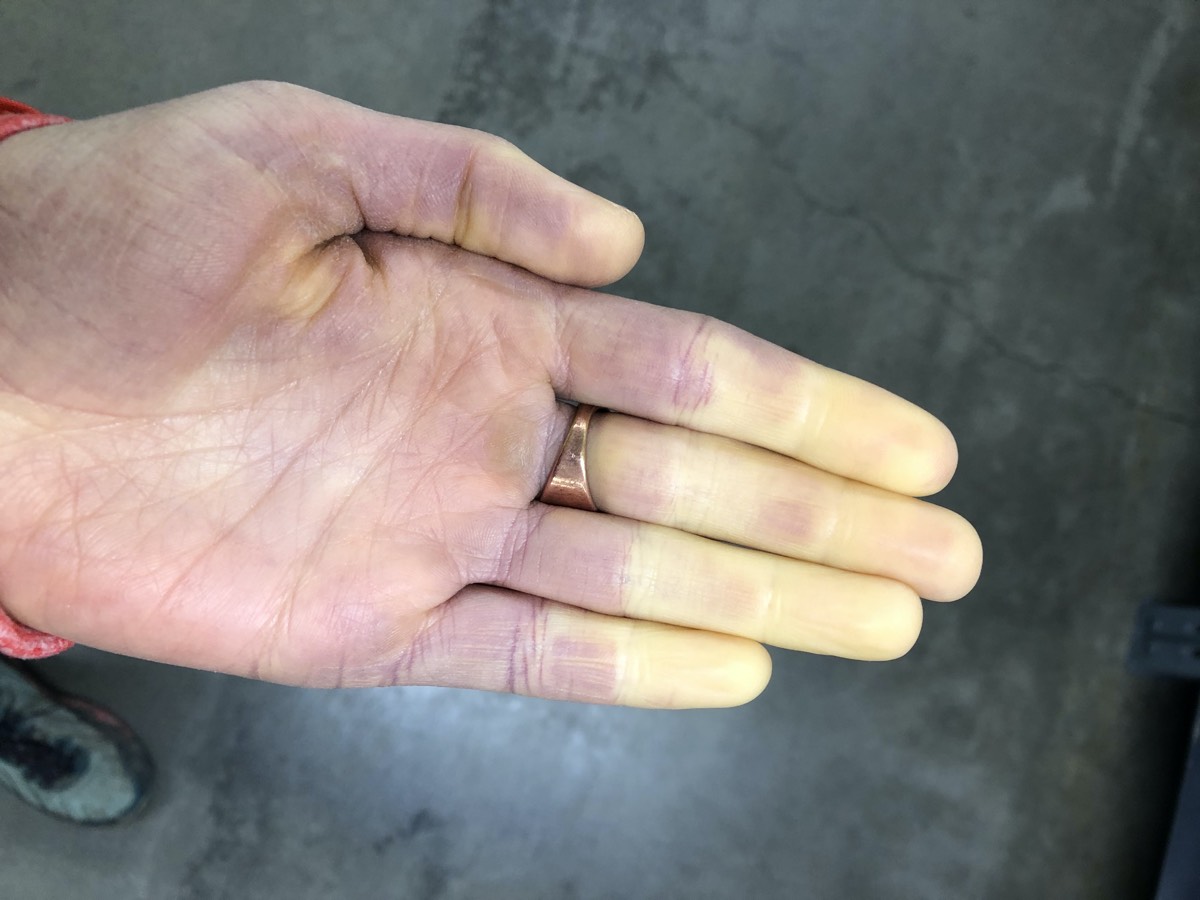Most people don’t know that I grew up figure skating in Wisconsin. That’s right, before I was a runner and a skier, I figure skated year round! One of my most vivid memories from this time is being curled up in the fetal position on a picnic table with mittens on my feet and hands crying as my numb digits rewarmed. I’ve had startlingly cold hands for as long as can remember, so much so that my brothers tease me by saying, “Cold hands, Cold heart!” However, when I joined our high-school cross-country team, I noticed a teammate who would don mittens if the temperature dipped below 60 degrees Fahrenheit. I knew immediately that I did not have the coldest hands on the team. My cross-country teammate had what I now know is Raynaud’s phenomenon, something I’ve also learned that approximately one out of every five of my female friends deals with–hold on, I promise the science is going to support me here!
So, what is Raynaud’s phenomenon? What can you do about it? And what about other cold-extremities issues such as cold injuries, the screaming barfies, and more? We’re addressing these questions in the rest of this article. While it’s definitely a niche topic, I hope it’s informative and maybe it’ll spare a few of us from acquiring the “cold hands, cold heart” moniker.
What is Raynaud’s Phenomenon?
Raynaud’s phenomenon (RP) was first described by Maurice Raynaud in 1862 as a vascular (circulation) issue that often happens with exposure to moderate cold but still “seemingly without reason” (1). During these episodes, a person’s fingers become bloodless, numb, and whitish yellow in color (2).
It took another 70 years for the etiological underpinnings of RP to become more apparent and universal diagnosis criteria to be formed. We now understand that Raynaud’s is most commonly seen with a marked biphasic or triphasic change in skin color (white to blue and sometimes to red) of the fingers (the thumb is often spared) (2). The white pallor is related to initial vasospasm/vasoconstriction (narrowing) of the blood vessels feeding the fingers, and the blue is from lack of oxygen to the tissue. If the fingers of a RP sufferer turn red, it is linked with the reperfusion (return of blood flow) which can sometimes also cause pain and tingling (2).
Vasoconstriction can be totally normal and is used frequently to help us with thermoregulation. As your core body temperature drops, peripheral (hands, feet, nose, ears, and more) vasoconstriction helps maintain your core body temperature. Likewise, when we get really warm, vasodilation sends more blood to our skin’s surface and “pushes” heat into the atmosphere around us. What makes RP an abnormal kind of vasoconstriction is that it can happen at considerably warmer temperatures and can even be triggered by stress. The medical community considers RP to be an overreaction or hypersensitivity.

On the left, the digital artery is wide (open) and has normal blood flow. On the right, vasoconstriction (narrowing) of the digital artery is restricting blood flow to the fingers and causing the discoloration. Image: Phillipsphiles.blogspot.com/2008/11/what-is-raynauds-disease.html
Is Raynaud’s Phenomenon Dangerous?
For those of us who are always just one click away from WebMD and concluding there is something seriously wrong with us–I am guilty of this–let’s talk about the two types of Raynaud’s phenomenon, primary and secondary Raynaud’s phenomenon. Primary RP is the more common and completely benign variety, whereas secondary RP is related to an underlying condition that could be more serious (3). While we can call take heart by learning that between 80 to 90% of people with RP have primary RP (4), you should speak with your primary care provider if you have RP symptoms.
Underlying conditions leading to secondary RP range in their severity. “More mild” conditions include a previous cold injury like frostbite or drug use such as estrogen-replacement therapy (because it alters blood flow) (9), anti-migraine drugs that contain ergotamine or sumatriptan (which cause vasoconstriction) (10), or beta-blockers (which slow heart rate and lower blood pressure) (10). The underlying conditions could also be more serious, like endocrine issues including hypothyroidism (which can cause a decrease in circulation) and connective-tissue disorders such as systemic sclerosis (an autoimmune disorder that attacks the body’s tissues, particularly your skin, joints, and internal organs) and chronic, systemic change in small blood vessels where they cannot return to normal size (3).
Interestingly, women are nine times more likely to have RP then men, with RP reported in as few about 1% of men and up to 20% of women depending on geographic location (3, 5). Although we do not know why this is so much more prevalent in women, we do know that there appears to be a heredity component (commonly having a first-degree relative with RP) and it is also common in people who suffer from other vasospastic conditions such as migraines (5). That’s a whole lot of white fingers!

Nikki Buurma’s hand has distinct blanching (white-yellow pallor) on all four digits that starts from the tip of the finger and ends as an abrupt line. Image courtesy of Nikki Buurma.
How to Manage Raynaud’s Phenomenon
Truthfully, the options for managing RP are not great, basically involve you staying warm, and will likely have you mumbling, “Well, duh!” As previously mentioned, secondary RP should be treated by medical professionals. Most people manage their primary RP without any medical intervention, instead opting for those easier “well duh” choices. Medical options for primary RP management include calcium-channel blockers and vasodilators (medicines which both relax and open small blood vessels in your hands and feet). However, the main tidbit of advice is identifying and mitigating what seems to trigger your vasospastic condition, and managing your thermoregulation when and where you can. The best recommendation the medical literature seems to have is “avoiding cold,” and that can be hard as a runner. If I’ve learned anything from my one-in-five female running partners, it is to always pack mittens and hand warmers.
I Don’t Have Raynaud’s Phenomenon, But I Do Have Cold Hands!
Maybe you’re like me, and you struggle with cold and maybe even painful hands but you don’t have RP. So, what gives then? A number of different scenarios could be taking place here. One distinct possibility is that you’ve experienced a non-freezing cold injury or a more serious injury like frostbite. These types of cold injuries start with your natural physiology trying to protect you. As your skin cools, you naturally experience cold-induced vasoconstriction, commonly in the hands and feet, but also in the nose, chin, earlobes, cheeks, and lips. This keeps warm blood protectively near your core, and happens in cycles lasting five to 10 minutes to conserve heat while also trying to not cause permanent damage to your extremities (6). If this cooling off is very rapid, ice crystals can form in the fluid outside of your cells, damaging cell membranes and causing the injuries you see more commonly in mountaineers that range in severity. Read more about frostbite in this iRunFar article. This type of cold injury, if repeated, can result in persistent sensory disturbances in your hands and feet including numbness, paresthesia (tingling), and chronic pain (11).
Or perhaps you are just a cold person? It turns out some people are just less tolerant of the cold than others. Sometimes this is caused by previous cold injuries such as frostbite, as mentioned above, but there are other reasons that you might be a cold person–and it’s not because you have a “cold heart.” Cold intolerance can be due to low body fat, having chronically high stress or anxiety (extra adrenaline released causes narrowing of blood vessels), disorders of the hypothalamus (the portion of your brain responsible for temperature control), and anemia (not enough blood circulating to your tissues).
There is one last condition, that I have a particular affection for, referred to in North American ice-climbing circles as the “screaming barfies” and in the worldwide community as the “hot aches.” If you’re lucky, you are sitting here wondering, “What in the world?” In fairness, both names are fairly descriptive. These conditions are usually localized to the hands or feet (most commonly the hands) and happen early in cold outdoor activities after a period of cooling or inactivity. For me, this is most common once I start skiing after spending time outside in the cold getting gear together. Most people experience pain, throbbing, and tingling which for many can progress to systemic symptoms including nausea, dizziness, transient loss of vision, and irritability (which honestly seems fair if you are trying to simultaneously cry, yell, not vomit, and if you’re me letting out a string of unmentionable words) (7, 8). Despite this being a common phenomenon, particularly in cold winter sports (about 81 to 96% of ice climbers report experiencing symptoms with about 60% experiencing them every time out), it is not understood why exactly this happens or more importantly why is happens to some people while not others (7, 8).
With so much left unknown, where does that leave us for advice? Back in the camp of practicality. Akin to dealing with primary RP or trying to avoid frostbite, there are lots of logical precautions to undertake. These include dressing appropriately for the weather conditions while maximizing loose, heat-insulating layers and avoiding constriction of body parts, opting for mittens over gloves for greater warmth and utilizing hand warmers if needed, staying dry by utilizing appropriate wicking materials like wool as opposed to cotton, and maintaining adequate hydration and nutrition to maintain normal fluid and electrolyte balances (6).
Call for Comments
- Do you have Raynaud’s phenomenon? Can you share about it?
- Have you experienced the screaming barfies or hot aches?
- What additional practical advice can you share for keeping your extremities comfortable in the cold?
References
- Herrick, A. L. (2005). Pathogenesis of Raynaud’s phenomenon. Rheumatology, 44(5), 587–596. doi: 10.1093/rheumatology/keh552
- Wigley, F. M., & Flavahan, N. A. (2016). Raynaud’s Phenomenon . The New England Journal of Medicine, 375(6), 556–565. doi: 10.1056/NEJMra1507638
- Belch, J., Carlizza, A., Carpentier, P. H., Constans, J., Khan, F., & Wautrecht, J. C. (2017). ESVM guidelines – the diagnosis and management of Raynaud’s phenomenon. Vasa, 46(6), 413–423. doi: https://doi.org/10.1024/0301-1526/a000661
- Pope, J. E. (2013). Raynaud’s phenomenon (primary) . BMJ Clin Evid.1119, 1-28. PMCID: PMC3794700
- Garner, R., Kumari, R., Lanyon, P., Doherty, M., & Zhang, W. (2015). Prevalence, risk factors and associations of primary Raynauds phenomenon: systematic review and meta-analysis of observational studies. BMJ Open, 5(3). doi: 10.1136/bmjopen-2014-006389
- Imray, C., Grieve, A., & Dhillon, S. (2009). Cold damage to the extremities: Frostbite and non-freezing cold injuries.Postgraduate Medical Journal, 85(1007), 481-488. doi:10.1136/pgmj.2008.068635
- Beyer, A., Ganti, A., & Byrne, B. (2017). Prevalence of the “Screaming Barfies” Among North American Ice Climbers.Wilderness & Environmental Medicine, 28(4), 367. doi:10.1016/j.wem.2017.08.013
- Melvin, A., & George, J. (2016). A Descriptive Study of Hot Aches: A Previously Unreported Winter Climbing Phenomenon.Sports Medicine – Open, 2(1). doi:10.1186/s40798-016-0062-z
- Serizawa I, Iwasaki N, Ishida H, Saito SY, Ishikawa T. G-protein coupled estrogen receptor-mediated non-genomic facilitatory effect of estrogen on cooling-induced reduction of skin blood flow in mice. Eur J Pharmacol. 2017 Feb 15;797:26-31. doi: 10.1016/j.ejphar.2017.01.013. Epub 2017 Jan 13. PMID: 28089920.
- Gilchrist, A. (n.d.). Common Drugs That Can Cause Raynaud’s Disease. Retrieved November 14, 2020, from https://www.pharmacytimes.com/news/common-drugs-that-can-cause-raynauds-disease
- Tom A Vale, Mkael Symmonds, Michael Polydefkis, Kelly Byrnes, Andrew S C Rice, Andreas C Themistocleous, David L H Bennett, Chronic non-freezing cold injury results in neuropathic pain due to a sensory neuropathy,Brain, Volume 140, Issue 10, October 2017, Pages 2557–2569, https://doi.org/10.1093/brain/awx215

